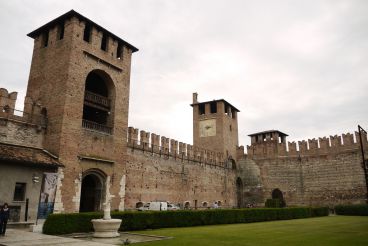Castelvecchio Castle, Verona

Castelvecchio Castle or the Old Castle is a fortified medieval structure in the center of Verona. Naturally, the purpose of the castle was the defense of the ruling family of Scaliger. For many centuries, it remained the most important fortification structure of the family. Nowadays, the Castelvecchio Museum is situated in a powerful and strict castle.
Castle history
A church built in the 8th century was situated on the site of the castle. It was dedicated to Saint Martin. Due to this, the fortress was originally called Castello di San Martino in Aquaro. The first fortified structures appeared near the Adige River in 1298 by order of Alberto I della Scala. In 1354, his descendant, Cangrande II della Scala began construction of a castle and a bridge across the river near the city walls. They were to become the main defensive structures of Verona.
The construction was entrusted to a faithful condotier and architect, Guglielmo Bevilacqua. Construction was completed in 1376. In the 16th century, 2 new castles appeared in the city, thanks to which the defense structure achieved the perfect combination. Then the first building was named Old Castle.
During the reign of the Republic of Venice, the castle was used as a barracks, warehouse and arsenal. In 1759, the Military Engineering College was located in the castle. In 1797, French troops turned the castle into fortified barracks and arsenals. This mission was maintained during the reign of Austria in 1816–1866. In 1870, the castle became the quartering place for the troops again.
In 1923–1926, a large-scale reconstruction took place. After it, the City Museum and Artillery School were placed here. The last restoration of the castle dates back to 1957.
Architecture and structure
Due to a number of interventions and rearrangements of the original structure the Scaliger castle in Verona looks as it is today. The three parts of the building are located at different heights and are separated by a large battlement built at the end of the 13th century. Stone, pebble, tuff were used as construction materials, but red brick and terracotta became the main one. The latter is very characteristic of all buildings of the medieval Verona. Parts of the castle differ from each other in structure and purpose:
- Palace. The residence of Scaligers was the heart of the castle and was located in the south of the whole complex. It has the shape of a trapezoid and is adjacent to the river, surrounded by a fortified wall. In a beautiful courtyard there is a suspension bridge adjacent to the tower with a gate. The Military College and the Artillery School were later housed here.
- Arsenal. This part of the castle is surrounded by the battlements connecting 4 towers. The only way to get inside was through the suspension bridge. The latter was built over a moat with water, which was completely drained in the 18th century. For a long time there were barracks and warehouses with weapons and provisions inside. Also, there are positions for guns in the walls of the towers.
- Fortress. The highest and most formidable structure of the castle, it is located in the western part of the complex. The fortification structure consists of powerful towers and walls. It is directly adjoined to the bridge over the Adige River.
Nowadays, there is a museum that preserves the rich cultural heritage of Verona inside the castle.
How to get there
Castelvecchio Castle (also Castelvecchio) is located on the banks of the Adige River, in the historical center of Verona, on Corso Castelvecchio, 2. Nearby there is the ancient Gavi Arch, not far from the Arena of Verona, the Museo Lapidario Maffeiano and the Gallery of Modern Art. The castle can be reached by buses 21, 22, 23, 24, 41, 173 (stop P.za Pasque Veronesi 5) and 31, 32, 33, 61, 62, 93, 94, 95 (stop Corso Cavour 49).
Opening hours: every day, from 8:30 to 19:30. On Monday from 13:30 to 19:30. Phone number (+39) 045 8062611.
Admission: the price of a full ticket is 6 euros, with a discount (14–30 and over 60 of age, groups of more than 20 people) – 4.5 euros. For children (8–13) as well as on the first Sunday of the month (from October to May) – 1 euro. For children under 8 – admission is free, as for visitors with a map of Verona. Data on the cost of admission and opening hours may vary.







